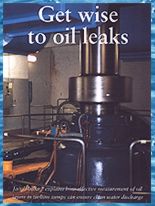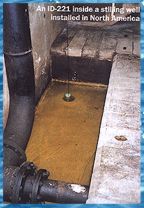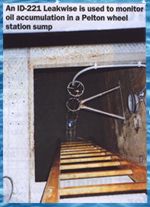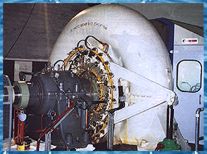 Oil spills into a local river can contaminate drinking water, or cause damage to
the aquatic fauna. Hydrocarbon leaks are a problem in old and new hydroelectric
plant. Oil can escape from turbine bearings and hydrodynamic seals, wicket gate
bushings, the hydraulic valve system (found in horizontal Francis turbines and
Pelton wheels, or dam gate actuators in vertical installations) and insulators.
One of the methods used to avoid polluting the main water stream is to seep a
small amount of water from the gaskets into the station sump and to treat the
water there
Oil spills into a local river can contaminate drinking water, or cause damage to
the aquatic fauna. Hydrocarbon leaks are a problem in old and new hydroelectric
plant. Oil can escape from turbine bearings and hydrodynamic seals, wicket gate
bushings, the hydraulic valve system (found in horizontal Francis turbines and
Pelton wheels, or dam gate actuators in vertical installations) and insulators.
One of the methods used to avoid polluting the main water stream is to seep a
small amount of water from the gaskets into the station sump and to treat the
water thereIn the US and Canada, dam gate actuators are positioned above the
waterline in a place where the inlet water vortex will not influence the top
water layer. Any leaks from the hydraulic actuators can be dealt with there.
However when closing the gate, the water head falls to tailwater elevation,
and all accumulated contaminates are drawn into the tailwater outlet. For this
reason it is important to monitor sumps at head gates. Most northern US and
southern Canada heads and sumps are 6-15m deep, compared, for example, to
northern Italy where there are 60-80m heads and 10-18m deep sumps.
Lubricants, usually insulating and hydraulic oils which seep into the station
sumps, form a floating oil sheen, or a thick oil layer. If left undetected, this
will eventually dissolve and cause severe damage.
Heavy lube and hydraulic oils have different characteristics, due to their
high polymer content and will disperse in the fluid proportionally to the
specific gravity fracture. In most cases, the temperature of the water and the
sump is 2-10C all year round. Thus heavy oils tend to form a lens on water and
not an evenly thick layer. At these temperatures, and in time, the water will
dissolve oils to a loading fracture of 200 to 2000ppm. In very low temperatures
the reaction will take several months; at 20C it will take several weeks.
Once an oil spill occurs, it will contaminate the concert sumps, and will ooze to the water surface. Cleaning will take anything from a single oil absorption, to several months of constant work, depending on the contamination. In order to avoid contamination, leaking. Oils from turbine bearings, hydraulic valves and other equipment are collected with water into turbine water collection sumps, which are usually located at the lower part of the station building. Water is discharged from the collection sumps by using submersible pumps, which draw clean water from the bottom of the sump leaving the floating oil layer on top. However, if this layers grows beyond a certain thickness, there is a risk that the vortex made by the pumping force will draw part of the oil from the top into the water, creating an emulsion which will be discharged with the water and contaminate the river.
Oil level sensors
 It is important to monitor the sump continuously, with a reliable oil detection sensor. Electromagnetic energy absorption sensors are replacing old capacitance sensors, and are now used successfully at many hydroelectric plants. The technology was implemented by Ionics Agar technologies, former sister of the Texas-based Agar corporation, after trying unsuccessfully to reliably measure oil/water interfaces and the concentration of oily emulsions with traditional conductivity and capacitance sensors. The conventional sensors were setting off false oil alarms although no oil layer was present, because dirt or oil had coated the electrodes. The sensors required intensive maintenance and had to be cleaned and recalibrated frequently. In addition, they were unable to detect oil layers less than 3-5mm thick, or the oil concentration in water continuous emulsions. This caused catastrophic discharges of oily water, which were falsely identified as clean. Additional problems were caused by the fact that the output of these old technology sensors was highly influenced by changed in water salinity and level changes.
It is important to monitor the sump continuously, with a reliable oil detection sensor. Electromagnetic energy absorption sensors are replacing old capacitance sensors, and are now used successfully at many hydroelectric plants. The technology was implemented by Ionics Agar technologies, former sister of the Texas-based Agar corporation, after trying unsuccessfully to reliably measure oil/water interfaces and the concentration of oily emulsions with traditional conductivity and capacitance sensors. The conventional sensors were setting off false oil alarms although no oil layer was present, because dirt or oil had coated the electrodes. The sensors required intensive maintenance and had to be cleaned and recalibrated frequently. In addition, they were unable to detect oil layers less than 3-5mm thick, or the oil concentration in water continuous emulsions. This caused catastrophic discharges of oily water, which were falsely identified as clean. Additional problems were caused by the fact that the output of these old technology sensors was highly influenced by changed in water salinity and level changes.
 Energy absorption technology was implemented in the Ionics Leakwise ID - 220 series of floating sensors. These instruments have overcome all the deficiencies of capacitance and conductivity sensors. The Leakwise sensors comprise a very high frequency transmitter connected to a mismatched antenna. The antenna is immersed in the monitored fluids.
The higher the energy absorption of the fluid, the more the loading on the antenna, and therefore more energy which has to be supplied by the transmitter. Water absorbs much more energy than oil and insulating materials such as air, glass or plastic. If the antenna is surrounded by an air and water mixture, the loading is proportional to the water content.
Energy absorption technology was implemented in the Ionics Leakwise ID - 220 series of floating sensors. These instruments have overcome all the deficiencies of capacitance and conductivity sensors. The Leakwise sensors comprise a very high frequency transmitter connected to a mismatched antenna. The antenna is immersed in the monitored fluids.
The higher the energy absorption of the fluid, the more the loading on the antenna, and therefore more energy which has to be supplied by the transmitter. Water absorbs much more energy than oil and insulating materials such as air, glass or plastic. If the antenna is surrounded by an air and water mixture, the loading is proportional to the water content.
This technique can continuously measure oil and water mixtures over the full range of 0-100%. It also enables continuous measurement of the presence or thickness of a floating oil layer. The high frequency transmitter is mounted on a float which maintains its position precisely at the liquid/air interface, despite fluctuations in the liquid level. It has two field - adjustable alarm points, to alert the operator to the presence of hydrocarbons or the hydrocarbon layer reaching a predefined thickness.
The Leakwise ID-220 series can detect a layer of of 0.3mm thick, repeatedly and, the manufacturer claims, with no false alarm. It can also monitor online changes in oil layer thicknesses up to 100mm. Signal processor relays with programmable response times enable detection, regardless of waves or turbulence. A stilling well can be designed for extreme conditions. A built-in-test device is continuously monitoring system operation.
The Leakwise system can be used in a hydro power plant to detect oil in the water collection sump under the turbines. Water carries oil leakages from the turbine bearings and other leaking sources into a large sump that is built under the turbines. In most plants, pumps installed at the bottom of the sump discharged the water directly to the river. An Ionics Agar Leakwise ID-221 floating oil detector is installed in a perforated 6in stilling well. The Leakwise ID-221 can detect the presence of a 300 micron (0.3mm) oil layer and measure its growth up to 25mm, using low and high alarm points that can be set by the user. A low oil alarm can be set off, for example, by a 2mm oil layer. Upon this alarm, the operator knows that he needs to clean or skim the oil from the water surface in the near future. A high oil detection alarm could be set off at 20mm. This alert the operator to what could be a catastrophic oil leak into the sump, requiring immediate action.
In some plants, the sump pumps discharge the water into oil/water separators. Water is pumped from the separator into retention tanks, and from there back to the river. An ID-223 oil sheen detector installed in the retention tank will set off an alarm at the presence of 0.3mm oil. A Leakwise ID-225 oil thickness monitor, installed in the separator, can measure the thickness of a 1-100mm oil layer continuously. The information is displayed via a 4-20mA output signal in the control room, and operators use the information to decide when to skim the oil. The sensor can also automatically start and stop a skimming pump.
 Oil and rainwater are collected from under the power plant's transformers into an underground tank. An ID-223 installed in this tank detects transformer oil leaks, and can be used for preventing discharge of oily water into the river or public drainage system. Dam gates are operated by hydraulic pressure. Environmental regulations forbid any discharged of leaking hydraulic oil into the river. ID-223 oil sheen detector can be used in dry or wet sumps built by the hydraulic pumps at the dam gates.
Oil and rainwater are collected from under the power plant's transformers into an underground tank. An ID-223 installed in this tank detects transformer oil leaks, and can be used for preventing discharge of oily water into the river or public drainage system. Dam gates are operated by hydraulic pressure. Environmental regulations forbid any discharged of leaking hydraulic oil into the river. ID-223 oil sheen detector can be used in dry or wet sumps built by the hydraulic pumps at the dam gates.
Oil sheen detectors
 Power companies equipping their hydroelectric plants with Leakwise oil detectors include pacific Gas & Electric in the US, BC Hydro and Ontario Hydro in Canada and ENEL in Italy. Ontario Hydro, for example, uses the Leakwise ID-221 oil sheen monitoring systems in many of its plants. At the NiAgara Falls station, 14 Leakwise detectors operate in sumps under the turbines. The Robert H Saunders station on the St Lawrence river uses eight Leakwise detectors.
Power companies equipping their hydroelectric plants with Leakwise oil detectors include pacific Gas & Electric in the US, BC Hydro and Ontario Hydro in Canada and ENEL in Italy. Ontario Hydro, for example, uses the Leakwise ID-221 oil sheen monitoring systems in many of its plants. At the NiAgara Falls station, 14 Leakwise detectors operate in sumps under the turbines. The Robert H Saunders station on the St Lawrence river uses eight Leakwise detectors.
Some of the systems are used for detecting lube oil leaks from turbine bearings, preventing discharge of contaminated water to the river. In a typical installation, the sensor is installed in a sump, which collects water coming from the turbine. The plant operators use the ID-221 alarms for manual control or to activate an automatic oil skimmer.
The Leakwise detectors are also used by Ontario Hydro for other applications. At Arnprior station, for example, they use Leakwise detectors

















